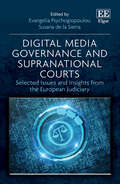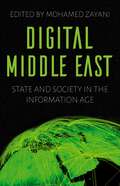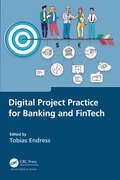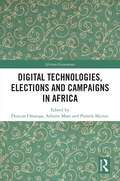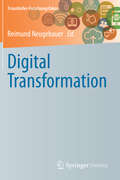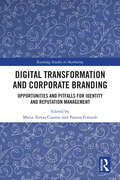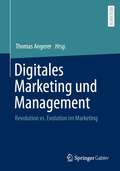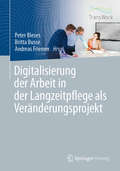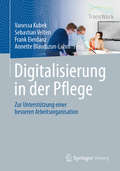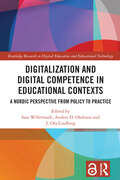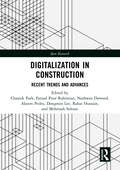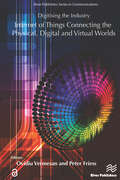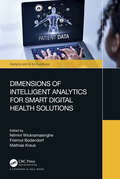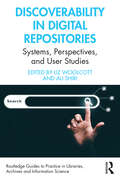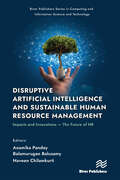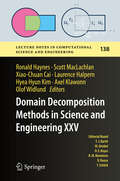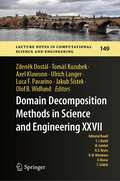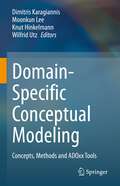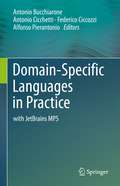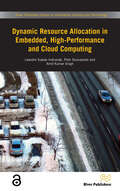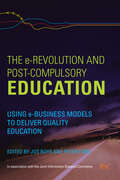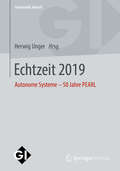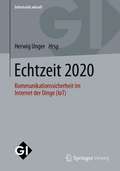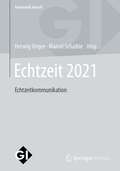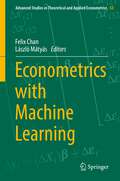- Table View
- List View
Digital Media Governance and Supranational Courts: Selected Issues and Insights from the European Judiciary
This timely book untangles the digital media jurisprudence of supranational courts in Europe with a focus on the CJEU and the ECtHR. It argues that in the face of regulatory tension and uncertainty, courts can have a strong bearing on the applicable rules and standards of digital media.Chapters written by expert contributors explore the interpretative steps taken by the CJEU and the ECtHR to solve arising legal issues, shedding light on their interpretation and refinement of the applied rules. The book provides fresh insights into the effects of European adjudication on the content and scope of the rules enforced and examines the ways in which the two European courts address the specificities of digitalization and digital media in their rulings. It also addresses the process of defining the constitutional boundaries of digital media and the exercise of rights and freedoms therein, focusing on digital media and the distinct challenges posed by digitalization and digital communication.Digital Media Governance and Supranational Courts will be a key resource for academics and scholars of European and Constitutional law, fundamental rights and digital transformation, as well as for students seeking a better understanding of the contribution of the CJEU and the ECtHR to digital media governance.
Digital Middle East: State and Society in the Information Age
In recent years, the Middle East's information and communications landscape has changed dramatically. Increasingly, states, businesses, and citizens are capitalizing on the opportunities offered by new information technologies, the fast pace of digitization, and enhanced connectivity. These changes are far from turning Middle Eastern nations into network societies, but their impact is significant. The growing adoption of a wide variety of information technologies and new media platforms in everyday life has given rise to complex dynamics that beg for a better understanding. Digital Middle East sheds a critical light on continuing changes that are closely intertwined with the adoption of information and communication technologies in the region. Drawing on case studies from throughout the Middle East, the contributors explore how these digital transformations are playing out in the social, cultural, political, and economic spheres, exposing the various disjunctions and discordances that have marked the advent of the digital Middle East.
Digital Project Practice for Banking and FinTech
New technology and changes in the regulatory framework have had a significant impact; various new players have emerged, and new business models have evolved. API-based ecosystems have become the new normal and collaboration in the financial and banking industry has reached new levels. Digital Project Practice for Banking and FinTech focuses on technology changes in the financial industry and their implications for business practice.A combination of practical experience in the field as well as academic research, the book explores a wide range of topics in the multifaceted landscape of FinTech. It examines the industry’s various dimensions, implications, and potential based on academic research and practice. From project management in the digital era to the regulation and supervision of FinTech companies, the book delves into distinct aspects of this dynamic field, offering valuable insights and practical knowledge. It provides an in-depth overview of various unfolding developments and how to deal with and benefit from them.The book begins by exploring the unique challenges and opportunities project management presents in the digital era. It examines the evolving role of project management and provides strategies for effectively navigating the complexities of digital transformation initiatives. The book then covers such topics as: Financial Technology Canvas, a powerful tool for facilitating effective communication within fintech teams Process automation implementation in the financial sector and related benefits, challenges, and best practices to drive operational efficiency and enhance customer experiences Robotic process automation in financial institutions Cyptoeconomics and its potential implications for the diffusion of payment technologies The efficiency and risk factors associated with digital disruption in the banking sector. At its core, this book is about real-world practice in the digital banking industry. It is a source of different perspectives and diverse experiences from the global financial and banking industry..
Digital Technologies, Elections and Campaigns in Africa (African Governance)
This book looks at how digital technologies are revolutionizing electoral campaigns and democratization struggles in Africa. Digital technologies are giving voice and civic agency to a cross section of African voters, providing important spaces for political engagement and debate. Drawing on cases from Kenya, Uganda, Mozambique, Nigeria, Ethiopia, and Zimbabwe amongst others, this book traces the shifts and tensions in this changing electoral communications landscape. In doing so, the book explores themes such as hate speech and disinformation, decolonisation, surveillance, internet shutdowns, influencers, bots, algorithms, and election observation, and looks beyond Facebook, Twitter, WhatsApp and YouTube to the increasingly important role of visual platforms such as Instagram and TikTok. Particularly highlighting the contribution of African scholars, this book is an important guide for researchers across the fields of African politics, media studies, and electoral studies, as well as to professionals and policymakers in political communication.
Digital Transformation
With the exception of written letters and personal conversations, digital technology forms the basis of nearly every means of communication and information that we use today. It is also used to control the essential elements of economic, scientific, and public and private life: security, production, mobility, media, and healthcare. Without exaggerating it is possible to say that digital technology has become one of the foundations of our technologically oriented civilization.The benefits of modern data technology are so impressive and the potential for future applications so enormous that we cannot fail to promote its development if we are to retain our leading role in the competitive international marketplace. In this process, security plays a vital role in each of the areas of application of digital technology — the more technological sectors are entrusted to data systems technology, the more important their reliability becomes to us.Developing digital systems further while simultaneously ensuring that they always act and respond in the best interests of people is a central goal of the technological research and development propagated and conducted by Fraunhofer.
Digital Transformation and Corporate Branding: Opportunities and Pitfalls for Identity and Reputation Management (Routledge Studies in Marketing)
Technological advances, alongside increasing globalisation and growing awareness of socio-cultural and socio-political issues, are driving corporate branding innovations, and organisations must react and adapt quickly to compete. This book investigates and explores the impact of digital transformation on building corporate branding, identity, and reputation. The book brings together international contributors to provide examples from a wide range of industries and fi rms, including the retailing and agri-food industries, and illustrates the many dimensions of corporate branding and theories, and how they can be aided by digital transformation. It explores the connection of branding with artificial intelligence, social media networks, and technologies 4.0 as well the limitations and challenges they might deliver. Using a combination of theory, primary research findings, and practice, the book offers viewpoints and expertise from multiple regions, appealing to a global audience. This edited collection serves as an importance resource for researchers, scholars, and postgraduate students of marketing, brand management, and corporate communications, and those interested in the emerging relationship with technology.
Digitales Marketing und Management: Revolution vs. Evolution im Marketing
Digitales Marketing und Management wird auf Basis eines neuen Bezugsrahmens konzipiert. Dieser Bezugsrahmen integriert mit Omnichannel-Marketing, Co-Creation, Customer Experience und Customer Journey die Kernelemente eines zeitgemäßen digitalen Marketingansatzes und führt sie im Kundenzentierten Marketing als neuem Basiskonzept zusammen. In diesem Zusammenhang werden Topthemen der aktuellen Diskussion zum digitalen Marketing und Management eingeordnet und in den einzelnen Beiträgen vertieft. Die Beiträge basieren auf umfangreichen Forschungsprojekten (Dissertationen) mit ausgeprägten empirischen Studien, in denen die Themen methodisch aufwändig untersucht werden.
Digitalisierung der Arbeit in der Langzeitpflege als Veränderungsprojekt
Digitale Arbeitsmittel dringen in Arbeitsbereiche vor, in denen sie bislang nur eine untergeordnete Rolle spielten. Die Langzeitpflege ist einer dieser Bereiche, in dem die Arbeit am Menschen und mit dem Menschen im Mittelpunkt steht. Die Akzeptanz digitaler Technik ist daher bei den Beschäftigten in der Pflege voraussetzungsreich. Um Chancen verwirklichen zu können, die in der Technik für gute Arbeit in der Langzeitpflege liegen, bedarf es einer umfassenden Planung, Einführung und Begleitung von Digitalisierungsprojekten. In diesem Band werden zentrale Dimensionen und notwendige Ressourcen des „Veränderungsprojekts Digitalisierung in der Langzeitpflege“ diskutiert. Zu bedenken sind nicht nur technische, ethische, arbeits- und datenschutzrechtliche Aspekte. Zudem sind für die erfolgreiche Integration in den Arbeitsalltag eine vorausschauende Arbeitsorganisation und Kompetenzentwicklung sowie eine partizipative und motivierende Lern- und Führungskultur bedeutend.
Digitalisierung in der Pflege: Zur Unterstützung einer besseren Arbeitsorganisation
Das Buch richtet den Blick systematisch auf jene Ansätze von Digitalisierung, die die Arbeitsorganisation in der Pflege verbessern und dadurch das Potential haben, zu einer höheren Zufriedenheit von Pflegekräften beizutragen.Digitalisierung in der Pflege wird aktuell sehr kontrovers diskutiert. "Werden Pflegekräfte in Zukunft durch Pflegeroboter ersetzt?" Solche und ähnliche Schlagzeilen werfen weitreichende ethische Fragestellungen auf und tragen nicht dazu bei, das Potential, welches Digitalisierung für die Pflegebranche bietet, sichtbar zu machen. Dieses Buch behandelt Ansätze von Digitalisierung, die Pflegekräfte in ihrer alltäglichen Arbeit unterstützen oder auch die Lebensqualität von Pflegebedürftigen erhöhen. Die vorgestellten Ansätze wurden wissenschaftlich fundiert entwickelt und haben sich in der Praxis bewährt. Das Buch zeigt auch auf, wie der Prozess digitaler Transformation in der Pflege erfolgreich umgesetzt werden kann - nämlich in einer Art und Weise, dass die in der Pflege Beschäftigten von Beginn an Gestalter ihres eigenen Veränderungsprozesses sind.Das Kapitel 8 „Nachhaltige Motivation durch wohlbefindensorientierte Gestaltung“ wird auf link.springer.com unter der Creative Commons Namensnennung 4.0 International Lizenz veröffentlicht.
Digitalization and Digital Competence in Educational Contexts: A Nordic Perspective from Policy to Practice (Routledge Research in Digital Education and Educational Technology)
This edited collection presents a Nordic perspective on intensified discussions concerning digitalization and digital competence in the current trends of educational work. Using a multidisciplinary and holistic approach, the book compares Nordic countries’ attitudes towards the digitalization of education and demonstrates the Nordic region’s position as digital front-runners in a European and a global context. The book provides up-to-date cases and future-oriented perspectives on digitalization and digital competence in educational work. Chapters use empirical data gained from policy documents, interviews, and questionnaires to present nuanced discussions, theoretical perspectives, and implications for the future of digitalization in education. Ultimately, this book’s reach far exceeds that of its Nordic contexts and will be of use to postgraduate students, researchers, and scholars across the globe involved with digital education, teacher education, and educational policy and politics more broadly.
Digitalization in Construction: Recent trends and advances (Spon Research)
This book highlights the latest trends and advances in applications of digital technologies in construction engineering and management. A collection of chapters is presented, explicating how advanced technological solutions can innovatively address challenges and improve outcomes in the construction industry. Promising technologies that are highlighted include digital twins, virtual reality, augmented reality, artificial intelligence, robotics, blockchain, and distributed ledger technologies. The first section presents recent applications of extended reality technologies for construction education and advanced project control. The subsequent chapters explore Artificial Intelligence (AI), blockchain, and BIM-enabled digitalization in construction through a series of case studies, reviews, and technical studies. Innovative technologies and digitalized solutions are proposed for improved design, planning, training, monitoring, inspection, and operations management in Architectural, Engineering and Construction (AEC) contexts. In addition to the technological perspectives and insights presented, pressing issues such as decarbonization, safety, and sustainability in the built environment are also discussed. This book provides foundational knowledge and in-depth technical studies on emerging technologies for students, academics, and industry practitioners. The research demonstrates how the effective use of new technologies can enhance work methods, transform organizational structures, and bring profound advantages to construction project participants.
Digitising the Industry Internet of Things Connecting the Physical, Digital and VirtualWorlds
This book provides an overview of the current Internet of Things (IoT) landscape, ranging from the research, innovation and development priorities to enabling technologies in a global context. A successful deployment of IoT technologies requires integration on all layers, be it cognitive and semantic aspects, middleware components, services, edge devices/machines and infrastructures. It is intended to be a standalone book in a series that covers the Internet of Things activities of the IERC - Internet of Things European Research Cluster from research to technological innovation, validation and deployment. The book builds on the ideas put forward by the European Research Cluster and the IoT European Platform Initiative (IoT-EPI) and presents global views and state of the art results on the challenges facing the research, innovation, development and deployment of IoT in the next years. The IoT is bridging the physical world with virtual world and requires sound information processing capabilities for the "digital shadows" of these real things. The research and innovation in nanoelectronics, semiconductor, sensors/actuators, communication, analytics technologies, cyber-physical systems, software, swarm intelligent and deep learning systems are essential for the successful deployment of IoT applications. The emergence of IoT platforms with multiple functionalities enables rapid development and lower costs by offering standardised components that can be shared across multiple solutions in many industry verticals. The IoT applications will gradually move from vertical, single purpose solutions to multi-purpose and collaborative applications interacting across industry verticals, organisations and people, being one of the essential paradigms of the digital economy. Many of those applications still have to be identified and involvement of end-users including the creative sector in this innovation is crucial. The IoT applications and deployments as integrated building blocks of the new digital economy are part of the accompanying IoT policy framework to address issues of horizontal nature and common interest (i.e. privacy, end-to-end security, user acceptance, societal, ethical aspects and legal issues) for providing trusted IoT solutions in a coordinated and consolidated manner across the IoT activities and pilots. In this, context IoT ecosystems offer solutions beyond a platform and solve important technical challenges in the different verticals and across verticals. These IoT technology ecosystems are instrumental for the deployment of large pilots and can easily be connected to or build upon the core IoT solutions for different applications in order to expand the system of use and allow new and even unanticipated IoT end uses. Technical topics discussed in the book include: • Introduction• Digitising industry and IoT as key enabler in the new era of Digital Economy• IoT Strategic Research and Innovation Agenda• IoT in the digital industrial context: Digital Single Market• Integration of heterogeneous systems and bridging the virtual, digital and physical worlds• Federated IoT platforms and interoperability• Evolution from intelligent devices to connected systems of systems by adding new layers of cognitive behaviour, artificial intelligence and user interfaces.• Innovation through IoT ecosystems• Trust-based IoT end-to-end security, privacy framework• User acceptance, societal, ethical aspects and legal issues• Internet of Things Applications
Dimensions of Intelligent Analytics for Smart Digital Health Solutions (Analytics and AI for Healthcare)
This title demystifies artificial intelligence (AI) and analytics, upskilling individuals (healthcare professionals, hospital managers, consultants, researchers, students, and the population at large) around analytics and AI as it applies to healthcare. This book shows how the tools, techniques, technologies, and tactics around analytics and AI can be best leveraged and utilised to realise a healthcare value proposition of better quality, better access and high value for everyone every day, everywhere. The book presents a triumvirate approach including technical, business and medical aspects of data and analytics and by so doing takes a responsible approach to this key area. This work serves to introduce the critical issues in AI and analytics for healthcare to students, practitioners, and researchers.
Discoverability in Digital Repositories: Systems, Perspectives, and User Studies (Routledge Guides to Practice in Libraries, Archives and Information Science)
While most discoverability evaluation studies in the Library and Information Science field discuss the intersection of discovery layers and library systems, this book looks specifically at digital repositories, examining discoverability from the lenses of system structure, user searches, and external discovery avenues. Discoverability, the ease with which information can be found by a user, is the cornerstone of all successful digital information platforms. Yet, most digital repository practitioners and researchers lack a holistic and comprehensive understanding of how and where discoverability happens. This book brings together current understandings of user needs and behaviors and poses them alongside a deeper examination of digital repositories around the theme of discoverability. It examines discoverability in digital repositories from both user and system perspectives by exploring how users access content (including their search patterns and habits, need for digital content, effects of outreach, or integration with Wikipedia and other web-based tools) and how systems support or prevent discoverability through the structure or quality of metadata, system interfaces, exposure to search engines or lack thereof, and integration with library discovery tools. Discoverability in Digital Repositories will be particularly useful to digital repository managers, practitioners, and researchers, metadata librarians, systems librarians, and user studies, usability and user experience librarians. Additionally, and perhaps most prominently, this book is composed with the emerging practitioner in mind. Instructors and students in Library and Information Science and Information Management programs will benefit from this book that specifically addresses discoverability in digital repository systems and services.
Disruptive Artificial Intelligence and Sustainable Human Resource Management: Impacts and Innovations -The Future of HR (River Publishers Series in Computing and Information Science and Technology)
It is well-established that every organization is founded with a specific purpose and goals. Virtually all business organizations obtain measurements and metrics dealing with outcomes and results. However, what is reflected on the balance sheet does not necessarily show the actual worth of the organizations and ensure their survival and sustainability. Thus, the question arises, what exactly makes the organizations sustainable and thriving in an ever-changing environment? There are several examples of companies like Faber-Castell, Bank of Ireland, Chivas, DuPont and many more which have been able to sustain and survive over more than 200 years and still have a successful existence in the present era. Thus, it is important for the organization to pay equal attention to its three bottom lines, i.e., people, profit and planet for its sustainability, which not only meet the needs of the present generation but should have a futuristic approach as well. In the present era, organizations are adopting a new normal working dynamic and coping with the post-pandemic situations to sustain themselves in the business environment. Technology plays a significant role in this new working dynamic, and cutting-edge technologies like machine learning, artificial intelligence, blockchain,ChatGPT, Internet of Things, and much more effectively facilitate human functioning at work. The book aims to contribute to understanding and developing sustainable human resource management processes and practices aligned with recent technologies. It highlights the interconnection among the three bottom-line sustainable approaches for the growth and development of the organization. Topics discussed in this book include: • Disruptive Technologies and HR Sustainability • Convergence of Innovative Technologies, HR and Organizational Growth • Triple bottom-line Sustainability for HRM • Business-oriented Talent analytics and HR Sustainability • Role of Leadership in sustainable HRM practices.
Domain Decomposition Methods in Science and Engineering XXV (Lecture Notes in Computational Science and Engineering #138)
These are the proceedings of the 25th International Conference on Domain Decomposition Methods in Science and Engineering, which was held in St. John's, Newfoundland, Canada in July 2018. Domain decomposition methods are iterative methods for solving the often very large systems of equations that arise when engineering problems are discretized, frequently using finite elements or other modern techniques. These methods are specifically designed to make effective use of massively parallel, high-performance computing systems. The book presents both theoretical and computational advances in this domain, reflecting the state of art in 2018.
Domain Decomposition Methods in Science and Engineering XXVII (Lecture Notes in Computational Science and Engineering #149)
These are the proceedings of the 27th International Conference on Domain Decomposition Methods in Science and Engineering, which was held in Prague, Czech Republic, in July 2022.Domain decomposition methods are iterative methods for solving the often very large systems of equations that arise when engineering problems are discretized, frequently using finite elements or other modern techniques. These methods are specifically designed to make effective use of massively parallel, high-performance computing systems.The book presents both theoretical and computational advances in this domain, reflecting the state of art in 2022.
Domain-Specific Conceptual Modeling: Concepts, Methods and ADOxx Tools
This book demonstrates the significance of domain-specific conceptual modeling through new research and development approaches that are manifested in each of the chapters. They include novel modelling methods and tools that emphasize the recent results accomplished and their adequacy to assess specific aspects of a domain. Each chapter offers detailed instructions on how to build models in a particular domain, such as product-service engineering, enterprise engineering, digital business ecosystems, and enterprise modelling and capability management. All chapters are enriched with case studies, related information, and tool implementations. The tools are based on the ADOxx metamodelling platform and are provided free of charge via OMiLAB. Furthermore, the book emphasizes possible future developments and potential research directions. The collection of works presented here will benefit experts and practitioners from academia and industry alike, including members of the conceptual modeling community as well as lecturers and students.
Domain-Specific Languages in Practice: with JetBrains MPS
This book covers several topics related to domain-specific language (DSL) engineering in general and how they can be handled by means of the JetBrains Meta Programming System (MPS), an open source language workbench developed by JetBrains over the last 15 years. The book begins with an overview of the domain of language workbenches, which provides perspectives and motivations underpinning the creation of MPS. Moreover, technical details of the language underneath MPS together with the definition of the tool’s main features are discussed. The remaining ten chapters are then organized in three parts, each dedicated to a specific aspect of the topic. Part I “MPS in Industrial Applications” deals with the challenges and inadequacies of general-purpose languages used in companies, as opposed to the reasons why DSLs are essential, together with their benefits and efficiency, and summarizes lessons learnt by using MPS. Part II about “MPS in Research Projects” covers the benefits of text-based languages, the design and development of gamification applications, and research fields with generally low expertise in language engineering. Eventually, Part III focuses on “Teaching and Learning with MPS” by discussing the organization of both commercial and academic courses on MPS. MPS is used to implement languages for real-world use. Its distinguishing feature is projectional editing, which supports practically unlimited language extension and composition possibilities as well as a flexible mix of a wide range of textual, tabular, mathematical and graphical notations. The number and diversity of the presented use-cases demonstrate the strength and malleability of the DSLs defined using MPS. The selected contributions represent the current state of the art and practice in using JetBrains MPS to implement languages for real-world applications.
Dynamic Resource Allocation in Embedded, High-Performance and Cloud Computing
The availability of many-core computing platforms enables a wide variety of technical solutions for systems across the embedded, high-performance and cloud computing domains. However, large scale manycore systems are notoriously hard to optimise. Choices regarding resource allocation alone can account for wide variability in timeliness and energy dissipation (up to several orders of magnitude). Dynamic Resource Allocation in Embedded, High-Performance and Cloud Computing covers dynamic resource allocation heuristics for manycore systems, aiming to provide appropriate guarantees on performance and energy efficiency. It addresses different types of systems, aiming to harmonise the approaches to dynamic allocation across the complete spectrum between systems with little flexibility and strict real-time guarantees all the way to highly dynamic systems with soft performance requirements. Technical topics presented in the book include: • Load and Resource Models• Admission Control• Feedback-based Allocation and Optimisation• Search-based Allocation Heuristics• Distributed Allocation based on Swarm Intelligence• Value-Based AllocationEach of the topics is illustrated with examples based on realistic computational platforms such as Network-on-Chip manycore processors, grids and private cloud environments.
The e-Revolution and Post-Compulsory Education: Using e-Business Models to Deliver Quality Education
Moving debates about ICT and higher education beyond a simple focus on e-learning, this book takes into consideration the provision of post-secondary education as a whole.Discussing what is meant by e-business, why e-business approaches are relevant to universities and colleges and the key issues this raises for post-secondary education, this book:examines emerging technologies and provides examples of what an e-institution for education might look like explores what can be learnt from e-business in re-defining the relationships between enterprises and their users and in developing processes to improve services and competitive advantage considers how to improve administrative efficiency, implement faster access and response to information, enhance skills and knowledge development and improve the student experience examines technological innovation and integration, leadership styles, risk assessment and cost-benefit type analyses, re-designing existing organisational frameworks, techniques for overcoming barriers to change and successfully implementing change and the types of technologies required for an e-integrated educational provision In a highly competitive educational marketplace, institutions need to react to and embrace new technologies to provide rich and competitive learning environments for the students of tomorrow. The discussion and guidance in this book is essential reading for all leaders, managers and heads of e-learning in higher and further education.
Echtzeit 2019: Autonome Systeme – 50 Jahre PEARL (Informatik aktuell)
Mit seinem Workshop 2019 zum Thema "Autonome Systeme - 50 Jahre PEARL" bietet der GI/GMA/ITG-Fachausschuss Echtzeitsysteme Wissenschaftlern, Nutzern und Herstellern ein Forum, auf dem neue Trends und Entwicklungen zu folgenden Programmschwerpunkten vorgestellt werden: 50 Jahre Echtzeitprogrammiersprache PEARL, Perspektiven von EZ-Systemen, Modellierung und Simulation, Koordination und Vernetzung, Bilderkennung und -verarbeitung, Funktionale und IKT-Sicherheit sowie KI unter Echtzeitbedingungen. Berichte zu aktuellen Anwendungen und zur Ausbildung runden die Publikation ab.
Echtzeit 2020: Kommunikationssicherheit im Internet der Dinge (IoT) (Informatik aktuell)
Mit seiner Tagung 2020 zum Thema „Kommunikationssicherheit im IoT“ greift der GI/GMA/ITG-Fachausschuss Echtzeitsysteme ein immer wichtiger werdendes Thema in einer mehr und mehr vernetzten Welt auf. Die präsentierten Lösungen reichen dabei von Hardware über Systementwurf bis hin zu einzelnen Applikationen. Ein historischer Rückblick sowie ein erstmals in einem Buch präsentiertes, kompaktes Tutorial der Programmiersprache OPENPearl, die u. a. mit der Zielsetzung, funktionale Sicherheit in Steuerungssystemen zu gewährleisten, im Fachausschuss entworfen wurde, runden die Darstellungen ab.
Echtzeit 2021: Echtzeitkommunikation (Informatik aktuell)
Mit seiner Tagung 2021 zum Thema „Echtzeitkommunikation“ greift der GI/GMA/ITG-Fachausschuss Echtzeitsysteme ein immer wichtiger werdendes Thema in einer mehr und mehr vernetzten Welt auf. Die präsentierten Lösungen reichen dabei von Hardware über Systementwurf bis hin zu einzelnen Applikationen.Das Buch stellt die auf der Tagung Echtzeit präsentierten Ergebnisse der Forscher auf dem diesjährigen Themengebiet der Echtzeitkommunikation dar. Diese Tagung des Fachausschusses Echtzeitsysteme der Gesellschaft für Informatik ist einzigartig im deutschem Sprachraum und fand 2021 zum 42. Mal statt.
Econometrics with Machine Learning (Advanced Studies in Theoretical and Applied Econometrics #53)
This book helps and promotes the use of machine learning tools and techniques in econometrics and explains how machine learning can enhance and expand the econometrics toolbox in theory and in practice. Throughout the volume, the authors raise and answer six questions: 1) What are the similarities between existing econometric and machine learning techniques? 2) To what extent can machine learning techniques assist econometric investigation? Specifically, how robust or stable is the prediction from machine learning algorithms given the ever-changing nature of human behavior? 3) Can machine learning techniques assist in testing statistical hypotheses and identifying causal relationships in ‘big data? 4) How can existing econometric techniques be extended by incorporating machine learning concepts? 5) How can new econometric tools and approaches be elaborated on based on machine learning techniques? 6) Is it possible to develop machine learning techniques further and make them even more readily applicable in econometrics?As the data structures in economic and financial data become more complex and models become more sophisticated, the book takes a multidisciplinary approach in developing both disciplines of machine learning and econometrics in conjunction, rather than in isolation. This volume is a must-read for scholars, researchers, students, policy-makers, and practitioners, who are using econometrics in theory or in practice.
